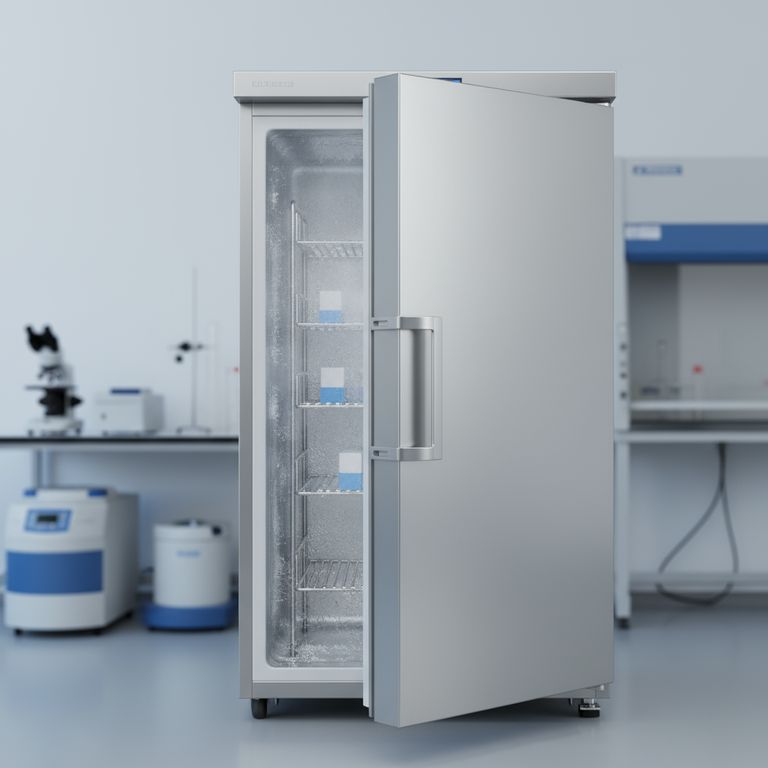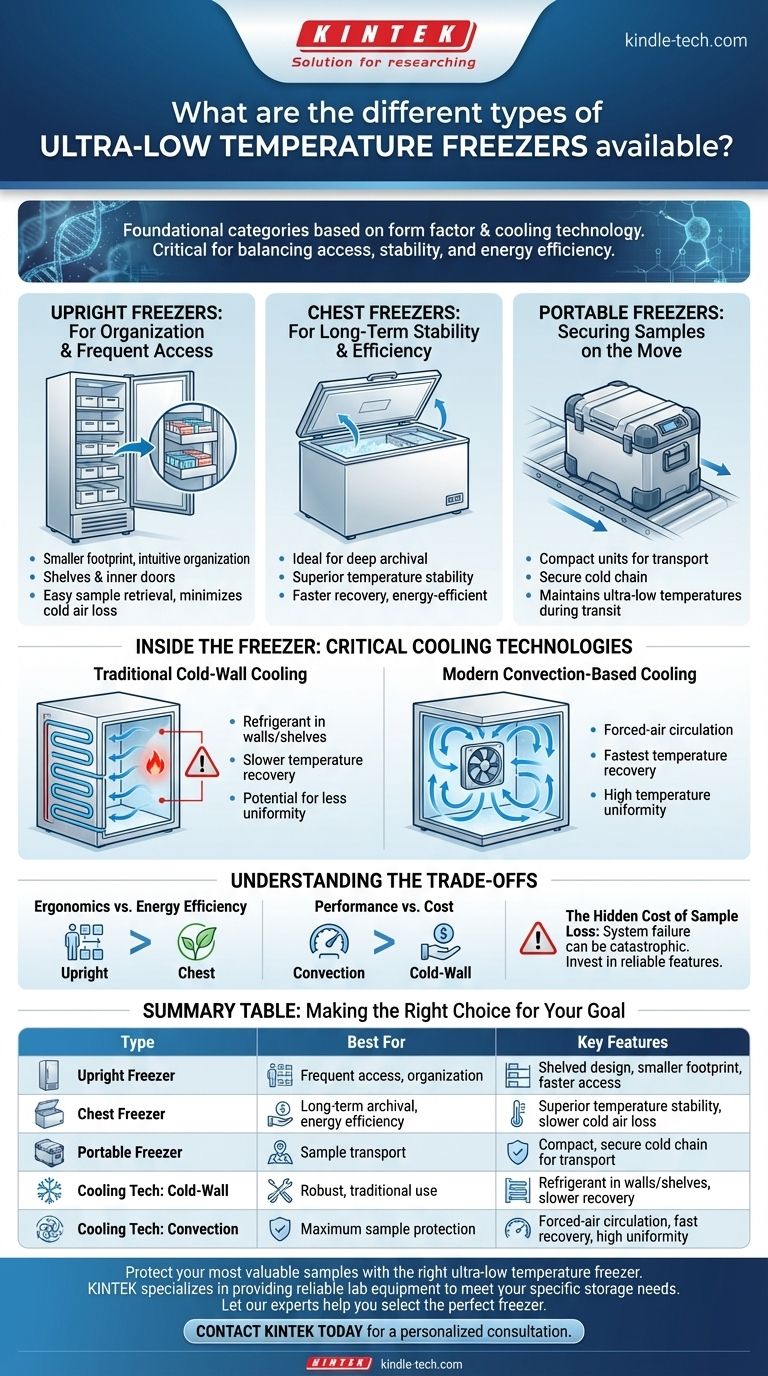At a foundational level, ultra-low temperature (ULT) freezers are categorized by their physical form factor and their cooling technology. The primary types are upright and chest freezers, designed for stationary lab use, and portable freezers for transport. Within the common upright design, a key distinction exists between older cold-wall cooling systems and modern convection-based systems that offer superior performance.
The choice between ULT freezer types is not merely about shape or size. It is a critical decision that balances the needs of daily access, long-term sample stability, energy efficiency, and the absolute requirement for temperature uniformity to protect irreplaceable biological materials.

The Fundamental Choice: Upright vs. Chest Freezers
The most visible difference between ULT freezers is their orientation. This single design choice has significant implications for lab workflow, space management, and energy consumption.
Upright Freezers: For Organization and Frequent Access
Upright freezers are the most common choice in modern laboratories due to their smaller footprint and ease of use. Their vertical design allows for intuitive organization on shelves, similar to a household refrigerator.
Samples are easily located and retrieved without needing to dig through layers of boxes. Most models feature separate inner doors for each shelf, which minimizes cold air loss when accessing a specific section.
Chest Freezers: For Long-Term Stability and Efficiency
Chest freezers are ideal for the long-term archival of samples that are not accessed frequently. Their design is inherently more energy-efficient.
When the lid is opened, the dense, cold air tends to remain inside the insulated basin rather than spilling out. This results in better temperature stability during openings and faster recovery times, making them a superior choice for deep archiving and power outage scenarios.
Inside the Freezer: Critical Cooling Technologies
Beyond the external shape, the method used to circulate cold air is a defining factor in a ULT freezer's performance, particularly regarding temperature consistency after a door has been opened.
Traditional Cold-Wall Cooling
In these designs, refrigerant lines are embedded directly in the freezer's walls and shelves. This technology is robust and has been used for decades.
However, its primary drawback is slower temperature recovery after door openings. It can also lead to less temperature uniformity throughout the chamber, with potential "hot spots" developing away from the refrigerated surfaces.
Modern Convection-Based Cooling
More advanced ULT freezers use forced-air circulation, or convection, to distribute cold air. A fan actively moves air throughout the chamber, ensuring a highly uniform temperature.
This method provides the fastest temperature recovery after access, which is critical for protecting sensitive samples. Convection systems are considered the most effective for maintaining strict temperature homogeneity required for valuable research materials.
A Specialized Category: Portable ULT Freezers
For clinical trials, remote sample collection, or transport between facilities, portable ULT freezers fill a critical niche.
Securing Samples on the Move
These compact units are engineered to maintain ultra-low temperatures while withstanding the rigors of transportation. They provide a secure cold chain for high-value biospecimens when they must leave the controlled environment of the laboratory.
Understanding the Trade-offs
Selecting the right ULT freezer requires an objective assessment of its strengths and weaknesses in the context of your specific needs.
Ergonomics vs. Energy Efficiency
Upright freezers offer superior ergonomics and organization, but at the cost of higher energy consumption compared to chest freezers. The frequent spilling of cold air during access places a greater load on the refrigeration system.
Performance vs. Cost
Convection-based systems deliver superior temperature uniformity and recovery, which is the gold standard for sample protection. However, this advanced technology often comes at a higher initial purchase price than traditional cold-wall models.
The Hidden Cost of Sample Loss
Features like audible alarms, remote monitoring, and robust cascade refrigeration systems are not luxuries; they are essential insurance policies. The cost of a freezer is insignificant compared to the value of the decades of research or unique patient samples it might contain. A system failure can be catastrophic.
Making the Right Choice for Your Goal
Your laboratory's workflow and storage philosophy should guide your decision.
- If your primary focus is frequent sample retrieval and organization: An upright freezer is the most practical choice, and a convection-based model will best protect samples from temperature fluctuations.
- If your primary focus is long-term, undisturbed archival: A chest freezer offers unmatched energy efficiency and temperature stability, making it the safest option for deep storage.
- If your primary focus is transporting samples between facilities: A dedicated portable ULT freezer is the only option that can guarantee the integrity of your cold chain.
Ultimately, choosing a ULT freezer is an investment in the security and integrity of your most valuable assets.
Summary Table:
| Type | Best For | Key Features |
|---|---|---|
| Upright Freezer | Frequent access, organization | Shelved design, smaller footprint, faster access |
| Chest Freezer | Long-term archival, energy efficiency | Superior temperature stability, slower cold air loss |
| Portable Freezer | Sample transport | Compact, secure cold chain for transport |
| Cooling Tech: Cold-Wall | Robust, traditional use | Refrigerant in walls/shelves, slower recovery |
| Cooling Tech: Convection | Maximum sample protection | Forced-air circulation, fast recovery, high uniformity |
Protect your most valuable samples with the right ultra-low temperature freezer.
The choice between an upright, chest, or portable ULT freezer is critical for your lab's efficiency and sample integrity. KINTEK specializes in providing reliable lab equipment, including a range of ULT freezers, to meet your specific storage needs—whether for daily research, long-term archiving, or secure transport.
Let our experts help you select the perfect freezer to ensure temperature stability, energy savings, and ultimate protection for your irreplaceable biological materials. Contact KINTEK today for a personalized consultation.
Visual Guide

Related Products
- 158L Precision Vertical Ultra Low Freezer for Laboratory Applications
- 808L Precision Laboratory Vertical Ultra Low Temperature Freezer
- 208L Advanced Precision Laboratory Ultra Low Temperature Freezer for Cold Storage
- 608L Essential Laboratory Ultra Low Temperature Freezer For Critical Sample Preservation
- 708L Ultra Low Temperature Freezer High Performance Laboratory Freezer
People Also Ask
- What advantages do ultra-low temperature freezers offer? Ensure Long-Term Sample Integrity and Reliability
- What features do ultra-low temperature freezers typically include? Ensuring Absolute Sample Security
- Where are ultra low temperature freezers commonly used? Essential for Labs, Hospitals, and Biotech
- What are ultra low temperature freezers used for? Preserving Critical Biological Samples for Decades
- In what fields are ultra low temperature freezers most commonly used? Essential for Biomedical, Clinical, and Research Labs



















